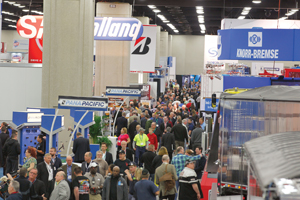Telematics Was MATS Focus

This story appears in the March 30 print edition of Transport Topics.
LOUISVILLE, Ky. — The growing prevalence of telematics for monitoring and refining the performance of trucks and linking drivers, fleets and manufacturers with vehicles dominated the 2015 Mid-America Trucking Show.
Original equipment manufacturers also used the March 26-28 event to announce equipment and aerodynamic improvements to incrementally increase fuel efficiency, while Daimler Trucks North America showcased its SuperTruck concept that in tests surpassed 12 miles per gallon.
(Extensive coverage from the Mid-America Trucking Show will be included in the April 6 edition.)
SHOWBUZZ: Complete MATS coverage
PHOTOS: Main | Scene | Trailers | Suppliers | Trucks | Engines and transmissions
MORE PHOTOS: Recruiting | Health | PKY Truck Beauty Championship
At many of the show’s media events, a prevalent theme was how rapidly trucking technology is evolving.
Nearly all companies said 2015 was shaping up to be a fantastic year for trucking, which will lead to continued strong vehicle and equipment sales. Several manufacturers suggested they were preparing for a possible pullback in orders next year, and to tackle the upcoming greenhouse-gas and other economically challenging federal regulations.
“The economic climate and the cost of regulations” have been barriers to adopting technology over the years, said Joe McAleese, chairman and CEO of Bendix Commercial Vehicle Systems. “The biggest way to gain [customer] acceptance and for them to understand the technology is to get them into a truck.”
In an effort to address just that problem, Navistar Inc. announced that it is making OnCommand Connection, its open architecture remote diagnostics system, a standard feature on all new International brand trucks. It also is being offered free of charge for all model year 2007 and newer trucks.
The company also announced it will provide a credit starting in July for base model telematics hardware and two years of data service.
Company executives, including CEO Troy Clarke, spoke of how these steps were part of the company’s ongoing turnaround and would help position it at the forefront of the technology movement going forward.
Navistar also was an integral part of Bendix’s introduction of Wingman Fusion, a warning and control system that combines several capabilities into one package.
Wingman Fusion uses cameras and radar to track following distances, detect vehicles in a truck’s path, monitor lane departure and warn drivers and fleets when a truck exceeds posted speed limits.
International is taking ProStar sleeper orders with the system, and it will be available on day cab and LoneStar models later in the year.
Shortly after Bendix’s announcement, Wabco introduced On-GuardACTIVE, its enhanced collision-mitigation system that provides longer-range detection than competing systems.
Before the show opened March 26, Cummins Inc. announced at a press event that it planned new products in 2017, including a model of its best-selling ISX15 engine. It also discussed its engine diagnostics program, providing fleets an alert as soon as a fault code is triggered.
Meanwhile, Volvo Trucks announced that its existing remote diagnostics system will expand in April beyond the engine to monitor fault codes on I-Shift automated manual transmissions.
Göran Nyberg, Volvo president of sales and marketing, said it is another step toward being able to “govern the whole electronic architecture of the truck.”
Similarly, sister company Mack Trucks said it is expanding its GuardDog Connect diagnostics platform to monitor its mDrive AMT.
Kenworth Truck Co. unveiled its TruckTech+ diagnostics system, which will be available for new trucks with the Paccar MX-13 engine starting this summer. PeopleNet is the telematics provider for the system. It also unveiled Nav+ HD — a multifunction communications and entertainment system, aimed at boosting driver retention by keeping them more connected on the road.
At its press event, Peterbilt Motors Co. touted its Rapid Check and SmartLinq programs that monitor truck maintenance problems.
Apart from safety and performance technologies, the truck makers’ media briefings included aerodynamic and equipment updates that reduced weight, and offered greater fuel economy and more options as fleets spec their vehicles.
Suppliers, including Dana, Eaton and Hendrickson, also exhibited their latest offerings.
As for DTNA’s SuperTruck exhibit, it turned into the flashiest event for the media.
Besides fuel-economy gains — achieved during a five-day, 312-mile round trip route on Texas Interstate 35 between San Antonio and Dallas — tests showed 115% freight-efficiency improvement and brake-thermal efficiency for the engine topping 50%, landing at 50.2%.
Diane Hames, DTNA’s general manager of marketing and strategy, noted that many of the features that went into developing the Super-Truck have gone into the Freightliner Cascadia Evolution and Western Star 5700XE, two of DTNA’s most fuel-efficient models.
DTNA’s SuperTruck program was funded through a $40 million grant from the U.S. Department of Energy and a matching investment from the company.
“It is our expectation that we will continue to review and refine what we’ve learned and achieved over the course of the SuperTruck initiative and use that knowledge to bolster our leadership in fuel efficiency,” said Derek Rotz, principal investigator for SuperTruck at DTNA.

